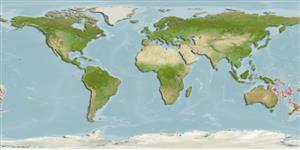Classification / Names
Nomi Comuni | Sinonimi | Catalog of Fishes(Genere, Specie) | ITIS | CoL | WoRMS | Cloffa
>
Callionymiformes (Dragonets) >
Draconettidae (Slope dragonets)
Etymology: Centrodraco: Greek, kentron = sting + Greek, drako = dragon (Ref. 45335); atrifilum: Named for the black filament on the second spine of the first dorsal fin; Latin 'ater' for black and ‘filum’ for thread..
More on author: Fricke.
Environment: milieu / climate zone / depth range / distribution range
Ecologia
marino benthopelagico; distribuzione batimetrica 437 - 640 m (Ref. 84091). Deep-water
Distribuzione
Stati | Aree FAO | Ecosystems | Presenze | Point map | Introduzioni | Faunafri
Western Pacific: Australia.
Size / Peso / Age
Maturity: Lm ? range ? - ? cm
Max length : 2.1 cm SL maschio/sesso non determinato; (Ref. 84091); 3.4 cm SL (female)
Short description
Morfologia | Morfometria
This species is distinguished by having the following characters: anal fin rays 12-13; second dorsal fin rays, 13-14; first dorsal fin with second spine elongate and filamentous in both sexes, the second dorsal fin with no filaments in males; male body colour pattern dorsally with 3 pairs of vertical dark brown streaks, followed by a single saddle below the end of the second dorsal fin and on the caudal peduncle (Ref. 84091).
Specimen was collected with a beam trawl, probably on soft bottom for species of Centrodraco usually occur on patches of soft substrate on the continental slope. Extremely rare in collections, and probably also biologically rare (Ref. 84091).
Life cycle and mating behavior
Maturità | Riproduzione | Deposizione | Uova | Fecundity | Larve
Fricke, R., 2010. Centrodraco atrifilum, a new deepwater dragonet species from eastern Australia (Teleostei: Draconettidae). Stuttgarter Beiträge zur Naturkunde A, Neue Serie 3:341-346. (Ref. 84091)
IUCN Red List Status (Ref. 130435)
Threat to humans
Harmless
Human uses
Informazioni ulteriori
Nomi ComuniSinonimiMetabolismoPredatoriEcotossicologiaRiproduzioneMaturitàDeposizioneSpawning aggregationFecundityUovaEgg development
Age/SizeAccrescimentoLength-weightLength-lengthLength-frequenciesMorfometriaMorfologiaLarveDinamica popolazioni larvaliReclutamentoAbbondanzaBRUVS
BibliografiaAcquacolturaProfilo di acquacolturaVarietàGeneticaElectrophoresesEreditarietàMalattieElaborazioneNutrientsMass conversion
CollaboratoriImmaginiStamps, Coins Misc.SuoniCiguateraVelocitàModalità di nuotoArea branchialeOtolithsCervelliVista
Strumenti
Special reports
Download XML
Fonti Internet
Estimates based on models
Preferred temperature (Ref.
123201): 6.7 - 10.2, mean 7.7 °C (based on 62 cells).
Phylogenetic diversity index (Ref.
82804): PD
50 = 0.5001 [Uniqueness, from 0.5 = low to 2.0 = high].
Bayesian length-weight: a=0.00389 (0.00180 - 0.00842), b=3.12 (2.94 - 3.30), in cm total length, based on all LWR estimates for this body shape (Ref.
93245).
Trophic level (Ref.
69278): 3.1 ±0.4 se; based on size and trophs of closest relatives
Fishing Vulnerability (Ref.
59153): Low vulnerability (10 of 100).
